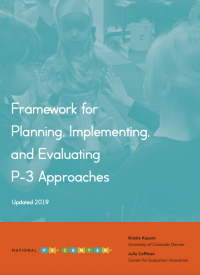P-3 Framework
The Framework for Planning, Implementing, and Evaluating P-3 Approaches anchors much of the work conducted by the National P-3 Center. The Framework was originally published in 2013 and was revised and updated in 2019 to embed a more intentional focus on equity.
The Framework is designed to address key questions facing those who are developing and implementing comprehensive P-3 approaches in their school, district, or community.
The Framework is divided into eight major “buckets” or categories of effort that require alignment within and between ECE/0-5 and PreK-12. Each bucket includes strategies that have been identified as essential to high-quality and comprehensive P-3 approaches.
While the electronic version of the Framework can be printed, the published version is easier to handle/read. Your first mailed copy is free and multiple copies cost a nominal fee. If you would like to request copies of the Framework, please email us.
Explorethe Framework
Use the toggles below to explore the eight framework buckets.
Comprehensive P-3 approaches require the collaboration and active engagement of diverse partners from different sectors (e.g., PreK-12 education; community-based pre-school and child care; Head Start; private or faith-based early learning programs; local, regional, state, and federal government).
Administrators — those who have budgetary, strategic, and supervisory responsibilities — are key stakeholders in comprehensive P-3 approaches. Administrators set organizational vision and priorities, establish budget and human capital resource allocations, and create a sense of teamwork and supportive accountability for results. With supervisory responsibilities for teachers and coaches, administrators also provide leadership for rigorous and developmentally appropriate instructional practices and environments.
Teachers—those who hold primary responsibility for providing instructional and emotional support to children—provide consistent influence on children’s learning experiences. Teachers’ skills, knowledge, dispositions, and perspectives should reflect a deep understanding of the early childhood developmental continuum.
Standards, curricula, and assessments greatly influence the content and nature of children’s learning experiences. However, when addressing the full pre-school through 3rd grade continuum, there are multiple, often disjointed, approaches to standards, curricula, and assessments. For example, when considering standards for what children should know and be able to do, at a minimum, there are state early learning guidelines, state-adopted K-12 standards (e.g., Common Core State Standards or other), and the Head Start Child Outcomes Framework that must be negotiated and incorporated into effective teaching strategies.
In some early childhood approaches, the environment is considered to be “the third teacher” (Reggio Emilia). Unfortunately, in many P-3 classrooms, the physical space, psychological climate, and instructional setting are often shortchanged.
Data are everywhere. Indeed, in many early childhood and elementary settings, practitioners are drowning in data. Data, however, provide important information to understand and monitor how well children, teachers, schools, organizations, and systems are doing. Since the early 2000s, there has been extensive emphasis on the use of child assessment data to inform education improvement. While it is important to have a clear understanding of how each and every child’s needs are being met, children alone should not bear the burden of proof. In comprehensive P-3 approaches, implementers rely on multiple data markers (e.g., classroom, school, program) to guide their efforts.
Effective family engagement is much more than bulletin boards and back-to-school nights. In comprehensive P-3 approaches, families are included as full partners in their children’s learning and development. Family engagement is a priority for all school and early learning staff, not just the school social worker or family support specialist.
P-3 alignment work can sometimes feel like administrative tasks, far removed from the lived experiences of children. Taking the perspective of each and every child is important. Is there consistent access, year after year, to high-quality programs? Is there attention to intentional, relationship-based transitions between age/grade levels? Are collaborative relationships being forged between partners who actually share responsibility for the same children?
P-3 Frameworkexamples
Lorem ipsum dolor sit amet, consectetur adipiscing elit. Ut elit tellus, luctus nec ullamcorper mattis, pulvinar dapibus leo.

